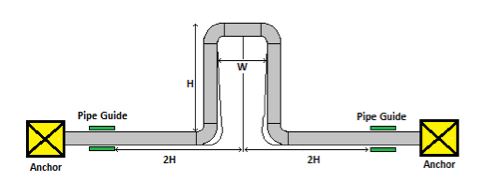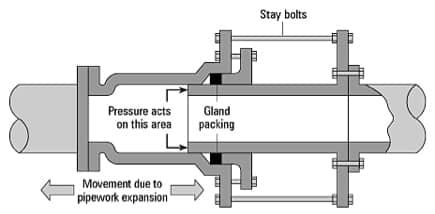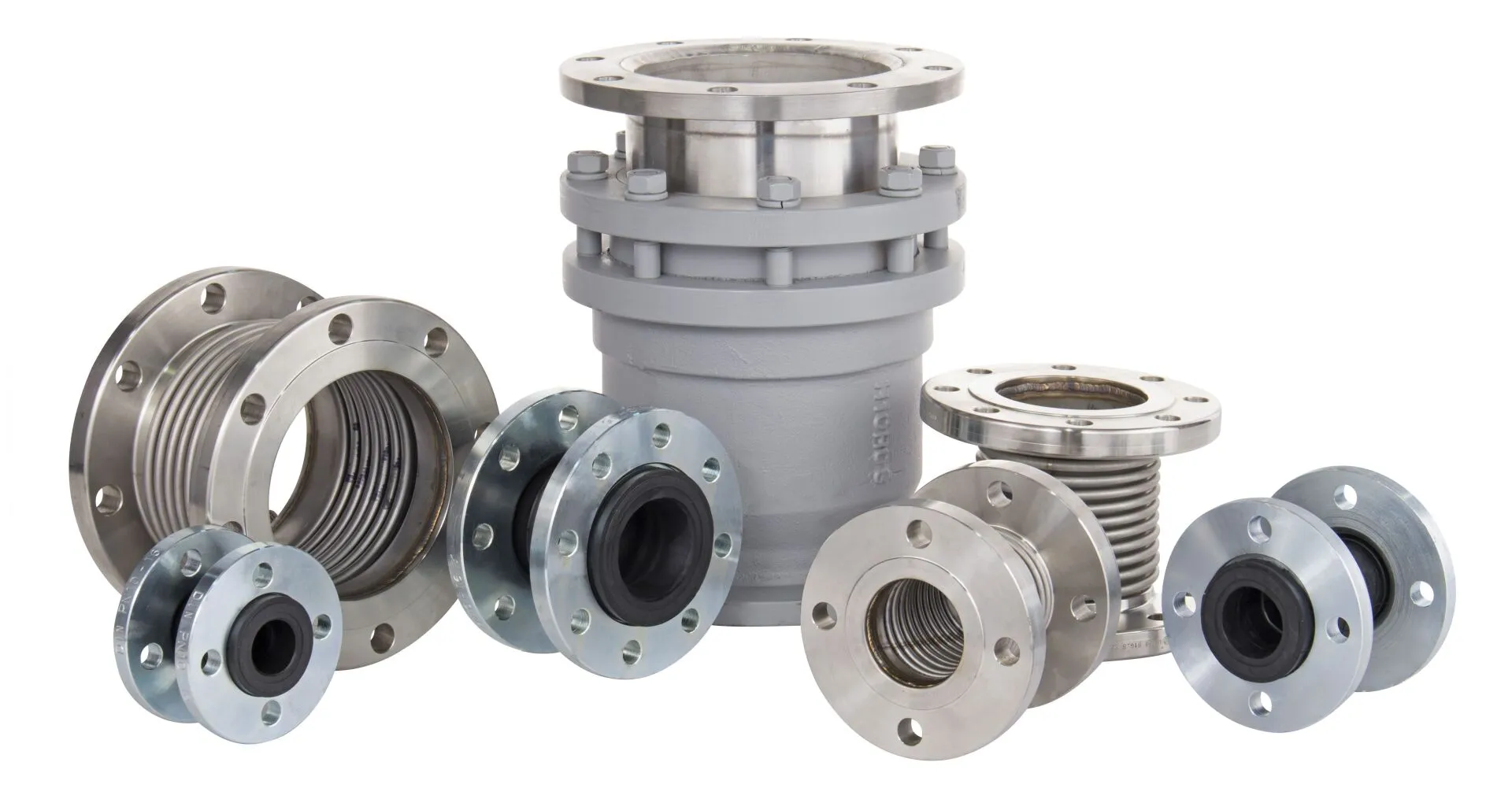Rubber expansion joint
is a flexible connector to absorb noise, shock, vibration, physical and thermal energy.
As piping systems heat and cool, they experience changes in length caused by thermal expansion and contraction. The amount of this thermal expansion depends on the length of the piping run, the temperature differential, and the alloy of the pipe. There are various types of expansion joints, each serving specific purposes. Here are some common types:

Pipe expansion loops accommodate thermal movements in a piping system by installing sections of piping that run perpendicular to the piping system, as pictured below. Although these loops are semi-rigid, they do allow for some movement, thus reducing stress loads on the anchor points in the piping system.
Pipe expansion loops must be carefully designed and installed so that the pipe, elbows, and welded joints are able to withstand the loads exerted on them. While pipe loops do not require maintenance, they take up a lot of room in the piping system layout and therefore are most often used in outdoor piping arrangements. Increasing the length of the pipe legs (H) decreases the forces exerted on the piping system.
If thermal movements are required in more confined spaces, then some manufacturers make flexible loops, which use corrugated metal hose assemblies for each leg of the loop. These flexible loops are more compact than pipe loops, but require structural supports to prevent sagging, or special drains in low points to prevent condensate accumulation. These hose loops are typically used where seismic protection is required, and should be replaced after a seismic event. Additionally, a series of ball joints may be incorporated into the pipe loops to increase the offset capability, but these are prone to leakage if not maintained properly
If there is no room for an expansion loop, then a component capable of axial movement should be considered. Two products that can handle axial (compression/elongation) movements are slip joints and expansion joints.

Slip-joints are installed in-line with the piping system, and compress as the pipe expands into them. This expansion is accommodated by a sleeve that slips into an outer shell. To prevent leakage through the slip joint, sealing materials are packed around the sleeve inside the shell.
Slip joints are very rugged components, and may be designed to allow for repairs without removing the joint. Slip joints are available in many different styles and configurations. However, they have several key limitations. First, slip joints can only accommodate axial movement (compression and elongation). Any lateral or angular movements can cause the inner sleeve to bind up inside the shell, limiting its ability to absorb thermal stress. Second, the packing material must be maintained and replaced regularly to prevent leakage. Too often, this maintenance is ignored, resulting in lost revenue from leaking steam or other media. Ball joints are similar to slip joints, except they are designed to handle angular movements. Ball joints also require regular maintenance of the packing material to prevent leakage. The need for a leak-free connection that can accommodate various movements has resulted in increased demand for expansion joints.
The most configurable types of expansion devices are metal expansion joints. They consist of one or more metal bellows, which are convoluted to provide flexibility.
A metal bellows expansion joint combines many of the benefits found in pipe loops and slip joints, while avoiding most of their shortcomings. Like pipe loops, properly designed expansion joints can be used to absorb thermal, mechanical, and/or seismic movements in any direction, and require no maintenance. Additionally, as with slip-type joints, expansion joints take up very little space in the piping system and can be designed to handle large axial movements. Unlike slip joints, expansion joints require no maintenance and can handle multiple movements. Expansion joints can be made from rubber, metal, or various polymers such as PTFE; although non-metallic expansion joints may cost less than metal expansion joints, they have limited temperature resistance and pressure-carrying capabilities, and can allow through-wall permeation of the media being conveyed. If the expansion joint is being installed outdoors, metal offers additional resistance to sunlight, ozone, temperature extremes and corrosive atmospheres (e.g. salt water) better than non-metallic components.
As you can see, there are various types of expansion devices to accommodate expansion and contraction in a properly designed piping system. Metal expansion joints offer many benefits and are increasingly relied upon to absorb these movements. Different styles, constructions, and hardware options can be used to customize the metal expansion joint for even the harshest of applications.
Not sure where to start?
Give us a call (+86 21 33780199) or send email to sales@sunnysteel.com today and we’ll be happy to discuss how we can help.

Expansion joints are crucial components used in various industries to absorb movement, vibration, and thermal expansion in piping systems and structures.
This is the most basic expansion joint possible, with just one bellows section and end connectors. In terms of anchoring and guidance, this form of expansion joint requires maximum control over the nearby pipes.
A central pipe portion connects two below parts in this expansion junction. This design allows for significant lateral deflection. In addition to lateral movement, the universal can allow for axial and rotational motion. This expansion joint does not have the necessary hardware to withstand pressure thrust. Like the single unconstrained growth common, the universal expansion joint must be adequately secured and supported.
This expansion joint is identical to the single unrestrained expansion joint, except it includes tie rods. When tie rods are added to the expansion joint, the bellows are prevented from overextending. The tie rods serve as limit rods, with stops placed to enable axial movement to a particular direction.
This expansion joint is identical to the universal expansion joint, except the tie rods are built into the unit. By using tie rods, you may limit pressure thrust. The pressure balancing development joint will not permit external axial movement until this pressure thrust force is overcome.
This expansion joint controls the pressure thrust and balances the pressure push, so the nearby pipe or equipment is not anchored. This pressure-balanced elbow expansion joint may be configured as a single or universal joint depending on how much lateral movement is necessary.
There is just one bellows segment in this expansion joint. The gimbal expansion joint uses two pairs of hinges coupled to a common centre floating ring to enable angular rotation in any plane. The gimbal expansion joint is often used in threes or with the hinged development joint.
This expansion joint has a single bellows portion and is only intended for angular movement in one plane. The hinge hardware is stiff in the axial direction to prevent axial movement of the expansion joint in piping systems. The hinged expansion joint is often used in threes or gimbal expansion joints.
This expansion joint is unique because it can absorb lateral, axial, and angular movement. This in-line pressure balanced expansion joint is used where primary anchoring is impossible, or pressure loads for equipment such as pumps and turbines are too high.

When you partner with Sunny Steel, you can stop worrying about meeting deadlines thanks to our responsive and timely service. You'll also say goodbye to unnecessary shopping around. Instead, you'll get white glove service from an expert who understands your needs and can get you the materials you need quickly.
